Shark Cage Diving Adventures at Farallon Islands
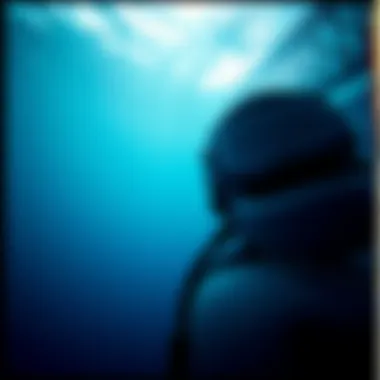
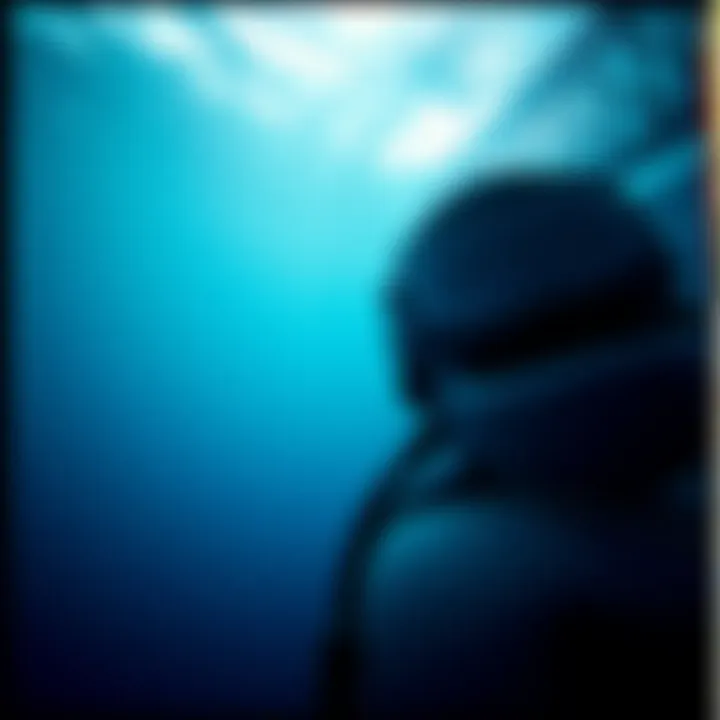
Intro
Shark cage diving is not just an adrenaline-packed adventure; it’s a gateway into the mysterious world beneath the waves. The Farallon Islands, situated off the coast of San Francisco, present one of the most thrilling opportunities to engage with nature’s true apex predators. As participants descend into the depths, they find themselves just inches away from the formidable yet mesmerizing great white sharks. This experience intertwines excitement with environmental education, prompting a broader awareness of marine conservation.
To truly appreciate this unique endeavor, one must understand its implications, from the specific gear needed to the critical safety protocols put in place. This guide aims to illuminate every aspect of shark cage diving at the Farallon Islands, offering essential insights for adventure travelers and nature enthusiasts alike.
Gear and Equipment
When preparing for a dive into shark territory, the right gear and equipment can make all the difference between a memorable experience and an unfortunate mishap. Shark cage diving requires specialized equipment tailored for safety and comfort while under the relentless waves.
Essential Diving Gear
- Wet Suit: A thick wetsuit keeps divers warm in the notoriously chilly waters. Opt for a suit with good flexibility and insulation.
- Diving Mask: A quality mask offers not only visibility but also comfort. It’s essential to ensure a proper fit to prevent leaks.
- Cage Structure: The cage, often made of durable stainless steel, is designed to withstand strong currents and provide safety from potential shark encounters.
- Weight Belt: This assists with buoyancy control, helping divers stay submerged while observing sharks comfortably.
"The awe-inspiring moment when a great white turns its gaze toward you while you’re safely in the cage is indescribable; it’s pure nature at its most raw."
Additional Equipment
Along with fundamental diving gear, consider incorporating various accessories that enhance the diving experience:
- Underwater Camera: Capture the thrilling moments with a waterproof camera; many tours offer rentals.
- Dive Computer: Monitoring depth and time is crucial under the water, ensuring safety and adherence to dive guidelines.
- First Aid Kit: Always have a basic medical kit on hand for unforeseen circumstances.
These pieces of equipment not only safeguard the diver but also enhance the overall experience of interacting with these magnificent creatures.
Safety Protocols
Every shark cage diving company must prioritize safety, and as a diver, understanding these protocols is quintessential. Adhering to these measures protects both individuals and the marine ecosystem.
- Pre-Dive Briefing: Comprehensive instructions usually precede the dive, outlining protocols and behavior to maintain safety and reduce risks.
- Buddy System: Divers are often paired with a buddy to ensure that no one is ever alone in the cage.
- Emergency Procedures: Knowing the procedures to follow in case of emergencies is vital and part of the pre-dive briefing.
- Environmental Awareness: Understanding the impact of human interaction with marine life encourages responsible tourism and conservation efforts.
The thrill of shark cage diving cannot be overstated; however, the responsibility that comes with it is just as crucial. By following safety protocols, divers can relish the experience while preserving the natural beauty of the marine environment.
Ending
Embarking on the journey of shark cage diving at the Farallon Islands offers an unparalleled opportunity to connect with marine life like never before. Understanding the gear required, adherence to safety protocols, and appreciating the vibrant ecosystem contribute significantly to the overall experience. As this guide illustrates, a thoughtful approach to adventure not only enhances personal enjoyment but also champions environmental stewardship in the face of rising human activity in our oceans.
For more information on marine life conservation and diving adventures, check resources such as Wikipedia on Shark Cage Diving and diving guides from Britannica. Additionally, engaging with communities on platforms like Reddit can provide insights from fellow divers.
Foreword to the Farallon Islands
The Farallon Islands, a chain of rocky outcrops situated about 30 miles off the coast of San Francisco, serve as a key gateway to an exciting underwater world. Known not only for their stunning landscapes but also for their vibrant marine ecosystems, these islands draw a crowd of adventure-seekers and nature enthusiasts alike. As we explore the thrilling experience of shark cage diving here, it’s crucial to first understand the geographical, biological, and historical backdrop that makes this area so special.
Geographical Overview
Nestled in the Pacific Ocean, the Farallon Islands are part of the Gulf of the Farallones National Marine Sanctuary. This area is protected due to its rich ecological significance. The islands themselves are composed of rugged cliffs and covered in a variety of plants, while the waters surrounding them teem with marine life. The unique underwater topography provides ideal hunting grounds for the famed great white sharks, which makes this location a prime spot for cage diving.
Most notably, the waters around the Farallons experience a specific upwelling phenomenon, where nutrient-rich waters from the ocean floor rise to the surface. This not only supports a diverse food web but also attracts larger predators, including sharks. Understanding this geographical setting gives visitors a glimpse into the wealth of encounters that await beneath the surface.
Rich Biodiversity
The biodiversity surrounding the Farallon Islands is second to none. Each year, thousands of marine animals migrate through this highly productive area. Visitors can observe a variety of wildlife, from playful sea lions and majestic seals to the diverse array of birds nesting on the islands. However, it is the shark populations that draw the most attention.
Sharks are crucial in maintaining the health of marine ecosystems, often referred to as apex predators. Great white sharks, in particular, are frequently sighted here and are a significant draw for divers. The sheer thrill of being enclosed in a cage while witnessing these magnificent creatures up close is a unique experience that many treasure for a lifetime.
Historical Context
Historically, the Farallon Islands have been shrouded in tales of mystery and fascination. From their use as a naval base during World War II to their lore as eerie, deserted outposts, these islands are steeped in a rich history that often piques the curiosity of both locals and tourists.
In more recent times, the Farallons have become a focal point for marine conservation efforts. The establishment of the Gulf of the Farallones National Marine Sanctuary in 1981 was a significant step towards preserving this ecological haven. Ongoing research and conservation efforts aim to protect not just the sharks, but the entire ecosystem that relies on the health of these waters.
By diving into the Farallon Islands and engaging with its vibrant life forms, adventurers not only experience thrill but also contribute to a wider understanding and appreciation of marine conservation.
Understanding Shark Cage Diving
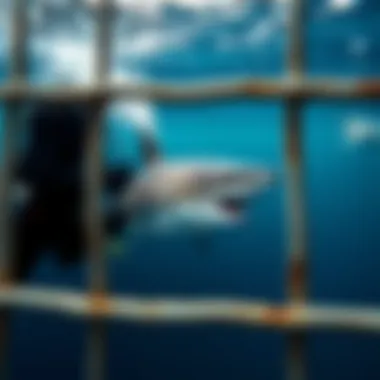
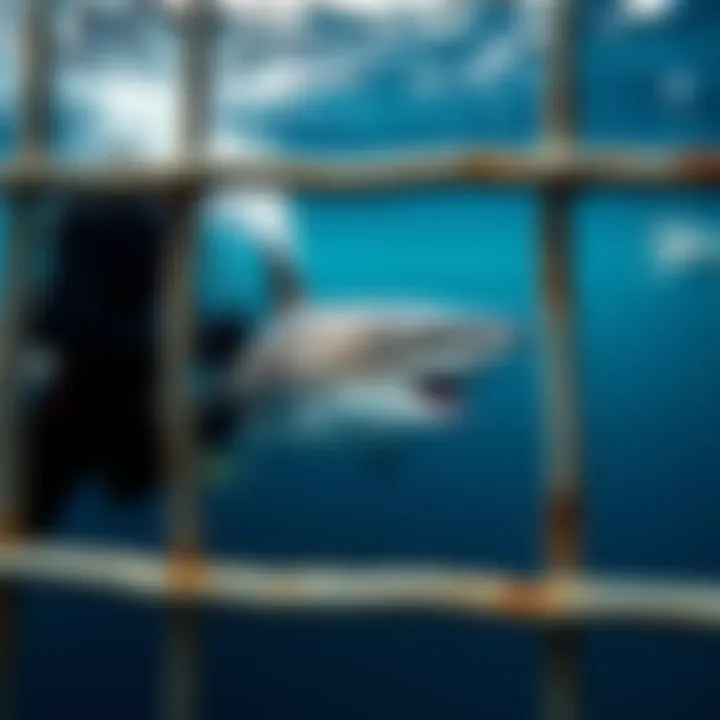
Shark cage diving presents not just an adrenaline rush; it’s an encounter that connects humans with one of nature's formidable creatures. Understanding this activity involves more than just the basics of getting in a cage and watching the sharks swim by. It's about grasping the nuances, risks, and the multifaceted benefits that come alongside immersion into the ocean's depths. This section seeks to explore the intertwined aspects of safety, ecology, and sheer thrill that are essential for anyone considering a dive at the Farallon Islands.
Purpose of Cage Diving
The main aim of shark cage diving is clear: to allow people to observe sharks, particularly great whites, in their natural habitat, all while ensuring safety through the protective bars of a cage. This thrilling experience attracts those who are not only adventure-seekers but also individuals fueled by curiosity about marine life. It brings awareness to the often-misunderstood nature of sharks, changing perceptions from fearsome predators to vital members of the marine ecosystem.
Moreover, cage diving serves an important educational purpose. By allowing divers to witness these magnificent creatures up close, it fosters a sense of responsibility toward marine conservation. Each encounter has the potential to inspire passion for environmental preservation, making more informed advocates out of ordinary folk.
Additionally, shark cage diving contributes to local economies, supporting businesses and communities connected to this unique tourism.
Types of Sharks Encountered
A dive at the Farallon Islands promises a front-row seat to one of the ocean's most captivating spectacles. It's not just about great whites; divers might encounter several different species that inhabit these waters.
- Great Whites: These are the rock stars of the show. Their size and powerful presence make for unforgettable moments as they glide through the water.
- Mako Sharks: Known for their speed, encounter with these sharks offers a glimpse of their agile hunting skills.
- Leopard Sharks: Smaller and often seen resting on the ocean floor, these sharks are usually harmless, making them a good introduction for first-time divers.
- Hammerhead Sharks: Their unique shape and behavior can be an incredible highlight, captivating divers with their distinct appearance and social behavior.
All these sharks play a role in the ocean's balance and understanding their habits and importance can deepen a dive experience beyond just being an extravagant thrill.
The Underwater Experience
Once the cage is lowered into the water, the reality of the underwater world sets in. It's surreal, being surrounded by the deep blue, with the sounds of the ocean creating a serene backdrop amidst the heart-pounding anticipation of shark sightings. This underwater experience is driven by several elements:
- Observation of Wildlife: The sheer delight of observing marine life in action is such a thrill. Watching sharks darting and gliding around the cage offers a visual feast. It's not just a view; it’s witnessing predation, social dynamics, and the grace with which these creatures move.
- Initiation into the Underwater Ecosystem: Divers find themselves immersed in a complex ecosystem, learning about the role of various species and the interconnectedness of marine life. It’s an education that goes well beyond the diving itself.
- Adrenaline and Awe: The blend of fear and exhilaration creates a unique emotional spectrum. Moments when a great white circles the cage instill a mix of awe and reverence for these powerful animals.
The underwater experience is transformative; it encapsulates a delightful rush and instills a deep respect for marine life, illustrating why shark cage diving at the Farallon Islands is such a sought-after endeavor for adventure travelers and naturalists alike.
"The thrill isn't just in seeing a shark; it's in recognizing their place in the ecosystem and our shared responsibility towards them."
By grasping the purpose, the sharks involved, and the intricacies of the underwater experience, divers can engage more richly with their journey, cultivating not just excitement but a greater understanding of the vital role that sharks play in our oceans.
Safety Considerations
The thrill of shark cage diving at the Farallon Islands comes with a hefty dose of responsibility. Understanding safety considerations is crucial, as they are the backbone of a successful and enjoyable diving experience. Preemptive measures not only ensure the well-being of divers but also guarantee that the sharks can thrive in their natural habitat without undue stress from human interaction.
Pre-Dive Briefing
Before stepping foot in the water, divers undergo a pre-dive briefing that is anything but a light chit-chat. This session dives deep into the specifics of cage diving where experienced guides outline what to expect throughout the adventure. It's in this briefing where critical guidelines emerge, such as:
- The importance of remaining calm and collected in the cage.
- Guidelines on how to behave if sharks come into view.
- What to do in an unforeseen scenario, like a technical malfunction.
Consider this briefing a compass for the journey ahead. It prepares divers not just mentally, but also physically, gearing them up with confidence while contributing to a collective understanding of safety.
Equipment and Gear
Shark cage diving involves specialized equipment designed with both safety and visibility in mind. The gear isn't just for show; it plays a pivotal role in ensuring divers remain secure while they get an up-close look at these magnificent creatures. Key equipment includes:
- Wetsuit: Keeps the diver warm in cool waters.
- Mask and Snorkel: Essential for visibility underwater.
- Safety Harness: Securely fastens divers inside the cage ensuring they won’t drift away.
- Emergency Floatation Device: Acts as a safety net to ensure that in case of an emergency, divers can be easily located.
Each piece of equipment is carefully inspected before the dive, as safety hinges on the reliability of these tools. It’s important to take a moment and really understand how each piece works. Knowing your gear builds nestleconfidence and allows one to appreciate the dive even more.
Emergency Protocols
While shark encounters are thrilling, complexity lurks behind the beauty of the ocean. It’s paramount that divers are well-acquainted with emergency protocols, as these can make the difference in unexpected situations. Protocols typically cover:
- How to alert the crew if there’s a problem: Knowing the call signals can be vital.
- Safe exit routes: Identifying the quickest ways to exit the cage if needed.
- Communication with dive instructors: Establishing that communication channel is essential to handle any unpredictable situations, whether it’s a personal emergency or equipment failure.
"Being prepared transforms uncertainty into confidence. A well-equipped diver is less likely to panic when challenges arise."
Engaging in shark cage diving at the Farallon Islands is undeniably exhilarating, but safety can't take a backseat. When divers familiarize themselves with the pre-dive briefing, gear, and emergency protocols, they not only safeguard themselves but also honor the surrounding marine environment. This commitment opens the door to rich experiences and encourages deeper connections with nature.
Logistics of Shark Cage Diving
Understanding the logistics of shark cage diving is crucial for anyone looking to embark on this unforgettable adventure. The logistics encompass everything from the initial planning stages to the final dive, highlighting what participants must consider, how to enhance their experience, and the practical aspects involved. Proper logistics ensure that the dive is not only exhilarating but also safe, organized, and responsible to the environment.
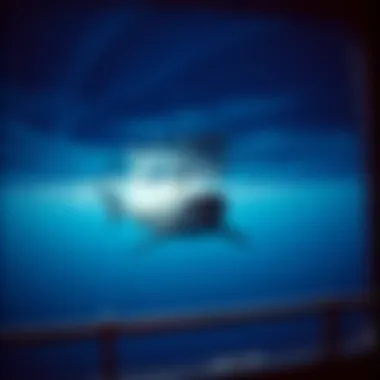
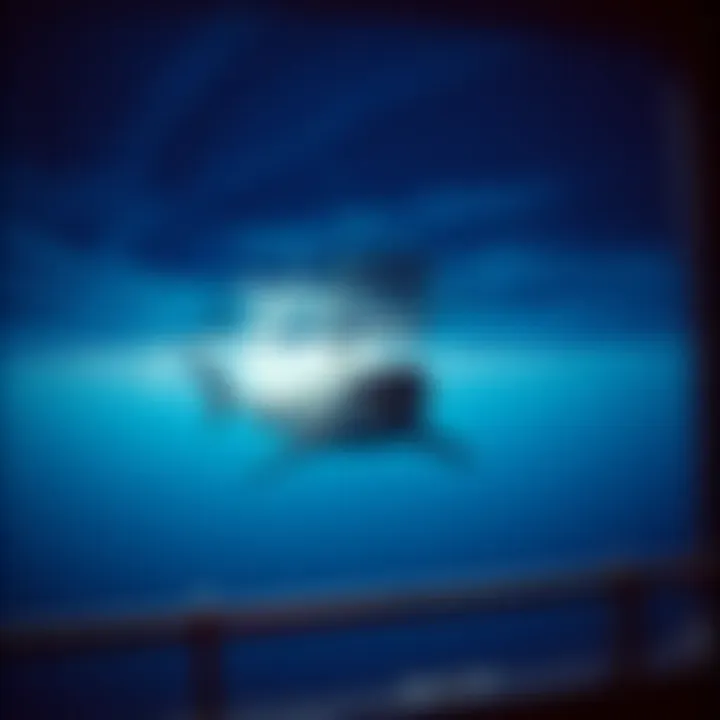
Booking a Diving Trip
Booking a diving trip to the Farallon Islands usually starts with thorough research on the companies that offer these experiences. Find a reputable operator known for its safety record and ethical practices. Websites and forum discussions can provide insights into customer experiences, and sites like TripAdvisor often have reviews on specific tours.
While some companies offer packages that include gear rental and meals, others might simply charge for the diving experience itself. Ask about hidden fees; clarity is key in this process. Popular options include:
- Full-day trips that combine shark viewing with marine biology presentations.
- Half-day excursions focusing strictly on the diving experience.
- Custom packages catering to specific interests or group sizes.
The goal is to secure your spot ahead of time, as these trips often fill up quickly, especially during peak seasons. Early booking not only guarantees a spot but might also open doors to better pricing.
Best Times to Dive
When considering the best times to dive, timing can make or break your experience. The Farallon Islands' waters are more inviting during late summer and early fall. The months from August through October are favored, as this period often sees warmer waters and increased shark activity. If you're hoping to catch a glimpse of great white sharks or other species, these months are typically the most productive.
However, each season brings its unique ecosystem dynamics. For instance:
- Winter months can be cooler but bring a different set of marine life.
- Spring often sees a mix and can be unpredictable but rewarding.
- Fall often presents amazing visibility conditions.
It’s also worth factoring in weather conditions, as fog can roll in quickly and affect not only visibility but also overall safety. Regularly check weather forecasts before your dive.
What to Expect During the Trip
Participants should prepare for a day filled with anticipation and excitement. Most shark cage diving trips begin early, with passengers meeting at a designated dock or marina. After a brief safety orientation, the boat heads out towards the cage drop-off point.
As the boat makes its way, the crew typically shares valuable insights about the marine life you may encounter. This is a chance to learn more about the sharks, including their behaviors and ecology.
Highlights of the dive experience include:
- Descending into the cage: Expect to squeeze into a sturdy, metal cage surrounded by water, ready to get up close to these magnificent creatures.
- Eye-to-eye encounters: If fortune favors you, moments witnessing sharks gliding near the cage can leave you filled with wonder.
- Photographic opportunities: Cameras are allowed, and crew members are usually happy to assist with capturing those once-in-a-lifetime shots.
A respectful approach to the sharks is emphasized, ensuring that their natural behaviors are not disrupted. Participants will likely get a guided narration throughout the dive, explaining what they are witnessing, making the experience richer.
In summary, the logistics of shark cage diving encompass a series of actions aimed at delivering not just safety but also an educational and thrilling experience at the Farallon Islands. Understanding how to book a trip effectively, when to dive for the best experience, and what to expect on the day will prepare you for a memorable interaction with the majestic sharks of the deep.
Ecological Impact of Shark Cage Diving
The practice of shark cage diving is not just about thrilling encounters with these magnificent creatures—it's also a practice that touches on deeper ecological conversations. Understanding the ecological impact of such activities allows enthusiasts to appreciate their experience while considering the broader implications of interacting with marine life. Emphasizing conservation and ethical tourism becomes paramount when sharing the ocean with apex predators like the great white shark. There are multiple facets to this impact, including how it affects shark populations, which regulations are in place to protect marine environments, and the role of awareness in promoting conservation efforts.
Impact on Shark Populations
Shark cage diving can potentially influence shark populations in various ways, both positive and negative. On the one hand, increasing tourism surrounding cage diving may help mitigate the declining numbers of certain shark species by generating both interest and funding for their conservation. Businesses involved in such activities often contribute a portion of their profits towards research and conservation initiatives, aiding scientists in better understanding these complex ecosystems.
However, there are risks as well. If not adequately managed, increased human presence could lead to stress or disrupted behaviors in sharks. For example, if baiting is improperly handled, it could alter feeding habits, making sharks dependent on human interaction instead of their natural prey. This complexity underscores the need for regulated practices in shark cage diving, ensuring a balance that supports ecological integrity while allowing for adventurous experiences.
Environmental Regulations
The Farallon Islands, like many sensitive marine areas, are equipped with a set of strict environmental regulations. These laws are designed to protect not only the sharks but the entire ecosystem that resides in these rich waters. Diver operations must adhere to guidelines set forth by local and federal authorities, primarily under the jurisdiction of the National Oceanic and Atmospheric Administration (NOAA) and the California Department of Fish and Wildlife.
Common regulations include:
- Limitations on the number of divers in the water at one time, to reduce stress on marine wildlife.
- Strict rules about baiting practices, ensuring that sharks are not lured into dangerous situations or made reliant on human activities for food.
- Prohibitions on certain behaviors, such as attempting to touch or interact directly with the sharks, which can lead to unintended consequences.
Adhering to these regulations not only promotes sustainability but also educates divers on the importance of maintaining ecological balance. Educated divers are more likely to share their knowledge with others, leading to a ripple effect in awareness and conservation efforts. This understanding is key to fostering an environment where sharks can thrive.
Promoting Conservation Awareness
One of the significant benefits of shark cage diving is its potential to raise awareness about shark conservation. Participants often leave the experience with a newfound respect and interest in marine life, which can motivate them to advocate for conservation initiatives. These experiences translate into compelling stories that can reach wider audiences, sparking conversations about the importance of preserving our oceans and the creatures that inhabit them.
Creating a direct connection to nature through cage diving fosters a sense of stewardship among divers. They become ambassadors for marine conservation, often sharing insights and encouraging sustainable practices within their communities. Educational programs offered by diving companies further enhance this awareness, providing information about the role sharks play in marine ecosystems and the threats they face from overfishing and habitat loss.
Strategies for promoting conservation awareness include:
- Workshops and talks focused on marine biology and conservation, presenting data and case studies.
- Social media campaigns highlighting personal experiences while in the cage, amplifying the message of preservation.
- Collaborations with environmental organizations to organize clean-up efforts or informational sessions.
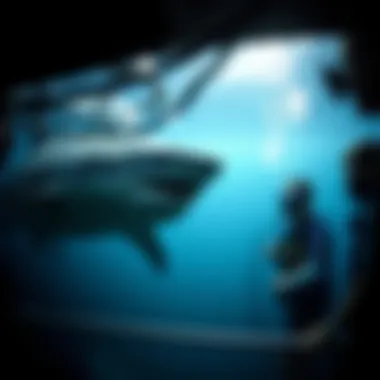
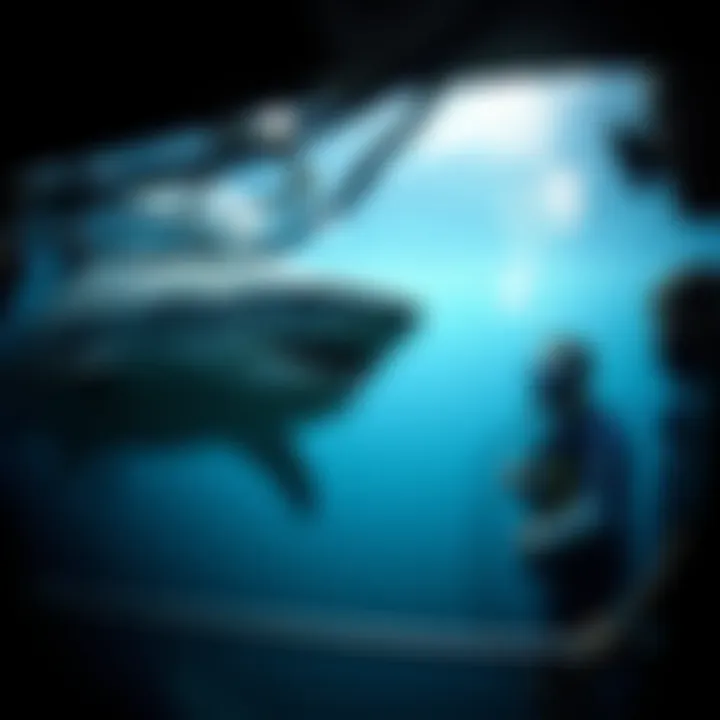
"Every dive isn't just about the thrill of seeing a shark; it's a chance to become part of the solution in protecting their future."
Guidelines for Responsible Tourism
Responsible tourism is not just a buzzword; it is a necessity, particularly in adventure travel like shark cage diving. As more travelers seek unique experiences like those offered in the Farallon Islands, it becomes crucial to understand how our interactions with marine environments can impact the ecosystem and local communities.
Respecting Marine Life
When venturing into the waters of the Farallon Islands, respecting marine life should be paramount. Visitors need to understand that they are guests in the sharks' habitat. Keeping a respectful distance ensures that the animals are not stressed or agitated. It’s important to remember that any kind of boastful behavior or loud disturbances can scare off wildlife or disrupt their natural behaviors. Here are a few key considerations:
- Adhere to local guidelines: Each diving company might have their own rules alongside regulatory requirements. Familiarize yourself with these to not only adhere to safety protocols but also to support conservation efforts.
- Avoid touching or feeding sharks: This may seem obvious, but it can be tempting. Hands off ensures that we don't inadvertently change their natural hunting behaviors.
- Educate yourself: Before even stepping in the cage, doing research about the local marine life can enhance your experience. Knowing their behaviors prepares you for the encounter.
"Every time we go out and disrupt these ecosystems while thinking we're just having fun, we risk creating a chain reaction that can impact biodiversity for years to come."
By respecting marine life, we not only protect it but enrich our own experience. Observing a shark in its habitat can be awe-inspiring and humbling, and such moments should not be taken for granted.
Supporting Local Communities
Engaging with the local communities around the Farallon Islands can enhance the diving experience while fostering sustainable practices. Responsible tourism isn’t just about the wildlife; it’s equally about people. Here’s why supporting the locals matters:
- Economic benefit: Tourists contribute to the economy when they choose local services—hotels, restaurants, and diving companies that prioritize sustainability. Encourage operators who give back to the community.
- Cultural exchanges: Learning about local traditions and lifestyles opens pathways for mutual understanding and respect. These interactions can significantly enrich your travel experience, creating a more meaningful journey.
- Sustainable practices: Supporting local businesses that practice sustainability measures makes a difference. Those businesses often engage in conservation efforts, helping to protect the marine life you came to explore.
Engaging with communities not only elevates your adventure but also strengthens ties between tourists and locals. An optimal experience blends adventure with responsibility, ensuring a legacy that future travelers can also enjoy. Together, we can create an environment where both the sharks thrive and local communities benefit.
Personal Experiences and Testimonials
When it comes to shark cage diving at the Farallon Islands, firsthand accounts from those who've taken the plunge are invaluable. These stories not only paint vivid pictures of the underwater encounters, they also bring to light the emotional and psychological aspects of this unique experience. Narratives from various divers capture the thrill, adrenaline rush, and even moments of introspection that stem from facing such magnificent creatures.
Diving into the depths with sharks isn't merely about the adventure; it's about understanding and appreciating the ocean's ecosystem. These narratives serve as a bridge, connecting prospective divers to the reality of shark cage diving, and enabling them to envisage their own journey.
Diver Stories
Diving stories can be as diverse as the divers themselves. A tale often recounted is that of a novice diver, Sarah, who faced her fear head-on. With trembling legs, she boarded the boat, recalling how she had been apprehensive about the immense size of great white sharks. However, once she was submerged within the cage, everything changed. "It felt like stepping into another realm," she reflected, describing the surreal experience of watching a shark glide past her. It’s these accounts that inspire others to embrace their fears and seek out adventure in the depths of the ocean.
Conversely, there are stories from seasoned divers who chronicle the evolution of their relationship with sharks. Jeremy, a marine biologist, shared, "On my first dive, I saw sharks as terrifying beasts, but over many encounters, I’ve grown to respect their majesty and intelligence." His narrative emphasizes how repeated experiences can alter one’s perception, transforming fear into admiration.
In short, diver stories capture not just the moments underwater, but the shifts in mindset and emotion that accompany such profound experiences. They often highlight the connection between humans and nature, urging others to share in the respect for marine life.
Photographic Insights
Photographic insights from shark cage diving trips stand as powerful testimonials in their own right. Each picture taken beneath the waves tells a story that words often fail to convey. Captured images showcase stunning close-ups of sharks, moments of joy, anxiety, or sheer awe from divers, reflecting the raw beauty and unpredictability of nature.
Shots of a diver looking eye-to-eye with a great white shark evoke a range of feelings—from exhilaration to vulnerability. These images have the ability to transcend language barriers, fostering a deeper appreciation for the marine ecosystem for all viewers. An image shared on platforms like Reddit, for example, can spark conversations about shark conservation and the fascinating lifestyles of these marine titans.
Furthermore, social media has created a platform for divers to share their insights and highlight their experiences. Diving-focused groups on Facebook allow divers to exchange precious photographs and stories, creating a community united by a common love for the ocean.
"Photos aren’t just about the thrill of the dive. They capture moments that can spark interest in marine conservation and responsible tourism." This illustrates how imagery can inform and inspire a broader audience, far beyond the initial participants of the dive.
In essence, both diver stories and photographic insights work hand-in-glove, creating a rich tapestry of experiences that beckon others to consider their own journey beneath the waves. Whether you’re an experienced diver or a curious first-timer, these accounts are essential. They lay the groundwork for compassion toward marine life and guide future adventurers toward responsible exploration.
End
Capping off our exploration of shark cage diving at the Farallon Islands, it's clear how vital this activity is, not just for thrill-seekers, but also for understanding marine ecosystems. The juxtaposition of excitement with profound ecological awareness makes it a unique experience. As divers descend into the depths, they don't merely confront great white sharks; they immerse themselves in a complex web of oceanic life that deserves respect and protection.
The Future of Shark Cage Diving
The future of shark cage diving hangs in a delicate balance, almost like a tightrope walk between adventure and conservation. As awareness about marine battles intensifies, there’s hope for a more sustainable approach. Innovations in technology, like eco-friendly diving gear and enhanced monitoring systems, can ensure that the practice enhances rather than harms the environment. There’s a growing trend towards ethical tourism; divers increasingly seek experiences that foster conservation efforts. Educational programs often accompany diving excursions, emphasizing the significance of sharks in marine ecosystems.
As we look ahead, collaborations between diving companies and environmental organizations may pave the way for a more informed dive industry, where protecting the ocean becomes a priority. The notion that every encounter contributes to conservation efforts can inspire many, making shark cage diving not just a personal adventure but a collective responsibility.
Final Thoughts
In closing, shark cage diving at the Farallon Islands stands as a captivating and transformative experience. It beckons enthusiasts to confront their fears and deepen their appreciation for the often-misunderstood great white shark. This isn’t merely a dunk into the ocean; it’s an opportunity to engage with nature at its rawest form.
The thrill of seeing these majestic creatures up close can shift one’s perspective about sharks from fear to fascination.
However, every diver has a role to play. Being mindful about choices and advocating for sustainable travel practices can ensure that future generations have the chance to share in this awe-inspiring adventure. The journey doesn’t end once you resurface; it carries on through stories shared, conservation initiatives supported, and the passions ignited that serve to protect our oceans. In the end, it’s about making a mark on both personal and global scales.
For any outdoor enthusiasts or travel bloggers, shining a light on these experiences can inspire meaningful actions, resonating far beyond the waters of the Farallon Islands.







